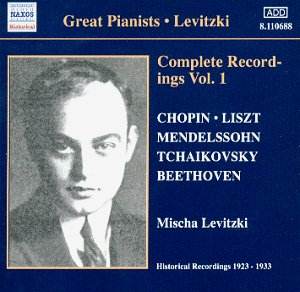Naxos’ Great Pianists series is now in full swing.
No sooner had I
reviewed Volume 2 of the Friedman and one of the latest Moiseiwitches
than the first in an edition devoted to Mischa Levitzki appears. Levitzki
was born in the Ukraine in 1898 and was sufficiently advanced to study,
at the age of seven, with Alexander Michalowski, a pupil of Moscheles
and Reinecke, at the Warsaw Conservatory. When Levitzki’s parents returned
to America – they were naturalised citizens – they settled in New York
where the young pianist continued his studies with Arthur Loesser’s
teacher Sigismund Stojowski. He then moved on to von Dohnányi
who took him on in 1913, after initial distrust, at the Berlin Hochschule
für Musik.
Often written off as a mere technician (the notes reprint
Horowitz’s scathing comment that Levitzki was "awful … just fingers.
There is a difference between artist and artisan. Levitzki is an artisan.")
the first volume covers the period from his late American Columbia acoustics
to the HMV electrics of 1933. The first item Levitzki ever recorded
was the Gluck-Sgambati Mélodie from Orfeo, a well-worn piece
for pearl-toned exquisites everywhere and yet what does Levitzki do
but distend it to almost four minutes of contemplative reflection. It
strikes me as rather lumpen at the tempo – the converse of, say, Petri’s
unalloyed beauty – but also strongly personalized. As if to show the
other side of his nature the Schubert-Tausig Marche Militaire is extremely
forthright. Elsewhere his virtues are hardly negligible; he makes fulsome
rubati in the Op. posth E minor Waltz of Chopin but manages to retain
comic detachment and vests the piece with genuinely attractive tone.
He dances delightfully through the G flat major Waltz and is suitably
poetic in the A flat major Etude. His Chopin as a group hardly seems
to me superficial in the strictest sense. The genre standby Moszkowski’s
La Jongleuse, so beloved of Moiseiwitsch who was making his recording
at around the same time as Levitzki, is pert and charming; there is
charisma aplenty in Liszt’s Sixth Hungarian Rhapsody, if some over-scaled
and thunderous playing at the conclusion. His own popular compositions
– the Op. 2 Waltz was taken up by many of his contemporaries – are effective
and attractive; the Op. 1 Valse de concert is rhythmically incisive
with a slow romanticized central section of real lyrical impulse. Needless
to say Levitzki powers through the conclusion and shows everyone how
to deploy filigree treble in the Waltz.
The remake of the E minor Waltz is an unpublished experimental
electric recording dating from November 1924 – seven months after the
commercial acoustic disc was recorded. It’s in fine sound and is played
with drive. His trills in La Campanella might be considered outrageous
by the more austere minded of listeners – there’s certainly a risk taking
cheek to his playing here even if his hyphenated Bach-Liszt fails to
convince. The Prelude is decidedly erratic and the Fugue supercharged.
The Scarlatti Sonata ends in hyper-romantic subjective style and his
London remake of the Marche Militaire again gives us his big boned drama.
Levitzki was not a prolific recording artist. He made
fifty-three published sides before his early death in 1943. He was certainly
uneven and could tend toward the gestural in his playing but there was
something at its core that remains not simply likeable or sympathetic
but curiously affecting as well.
Jonathan Woolf

